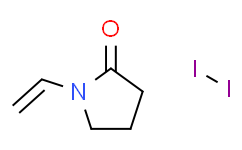| 中文名称: | 聚乙烯吡咯烷酮碘络合物 | ||||
|---|---|---|---|---|---|
| 英文名称: | Poly(vinylpyrrolidone)–Iodine complex | ||||
| 别名: | 聚维酮碘 PVP-I | ||||
| CAS No: | 25655-41-8 | 分子式: | C6H9NO.I2 | 分子量: | 364.95 |
| CAS No: | 25655-41-8 | ||||
| 分子式: | C6H9NO.I2 | ||||
| 分子量: | 364.95 | ||||
| MDL: | MFCD00084483 | ||||
基本信息
|
产品编号: |
P10075 |
||||
|
产品名称: |
Poly(vinylpyrrolidone)–Iodine complex |
||||
|
CAS: |
25655-41-8 |
储存条件 |
粉末 |
室温 |
四年 |
|
|
|
||||
|
分子式: |
溶于液体 |
-80℃ |
6个月 |
||
|
分子量: |
364.95 |
-20℃ |
1个月 |
||
|
化学名: |
PVP-I |
||||
|
Solubility (25°C): |
|||||
|
体外:
|
DMSO |
28mg/mL |
|||
|
Ethanol |
28mg/mL |
||||
|
Water |
28mg/mL |
||||
|
体内(现配现用): |
1.请依序添加每种溶剂:10% DMSO→40% PEG300→5% Tween-80→45% saline Solubility:≥1.5mg/mL(Infinity mM);Clear solution |
||||
|
此方案可获得 ≥ 1.5 mg/mL (Infinity mM,饱和度未知) 的澄清溶液。 以 1 mL 工作液为例,取 100 μL 15.0 mg/mL 的澄清 DMSO 储备液加到 400 μL PEG300 中,混合均匀;向上述体系中加入50 μL Tween-80,混合均匀;然后继续加入 450 μL生理盐水定容至 1 mL。 |
|||||
|
2.请依序添加每种溶剂:10% DMSO→90% (20%SBE-β-CD in saline) Solubility:≥1.5mg/mL(Infinity mM);Clear solution |
|||||
|
此方案可获得 ≥ 1.5 mg/mL (Infinity mM,饱和度未知) 的澄清溶液。 以 1 mL 工作液为例,取 100 μL 15.0 mg/mL 的澄清 DMSO 储备液加到 900 μL 20% 的 SBE-β-CD 生理盐水水溶液中,混合均匀。 |
|||||
|
<1mg/ml表示微溶或不溶。 |
|||||
|
普西唐提供的所有化合物浓度为内部测试所得,实际溶液度可能与公布值有所偏差,属于正常的批间细微差异现象。 |
|||||
|
请根据产品在不同溶剂中的溶解度选择合适的溶剂配制储备液;⼀旦配成溶液,请分装保存,避免反复冻融造成的产品失效。 |
|||||
生物活性
|
产品描述 |
缓释碘制剂,碘化脂质并氧化细胞化合物,用做碳纳米管涂层剂以改善水溶性,防腐剂。 |
|
靶点 |
Bacterial |
|
体外研究 |
MIC values of Povidone iodine (iodopovidone) (PVP-I) are 31.25mg/L and 7.82mg/L,respectively.Treatment of the cells with Povidone iodine (PVP-I) at a dilution of 1:32 causes a sharp reduction in cell viability by 90-95% on all testing cell lines. |
|
体内研究 |
The Dp+Povidone iodine (iodopovidone) (PVP-I) group has the second highest average score from day 13 to the end of the experimental period.The Dp+Povidone iodine and Dp+Et-OH groups also show a significantly increase in eosinophil count compare with the control group (p<0.05 and p<0.001,respectively).However,the eosinophil count does not significantly differ among the Dp+Povidone iodine (PVP-I),Dp+CHG,and Dp+vehicle groups. |
推荐实验方法(仅供参考)
|
细胞实验: |
|
|
Each bacterial isolate is washed twice with phosphate-buffered saline (PBS, pH 7.2),centrifuged for 10 min at 1932xg at 20℃,and suspended in 3mL of nutrient broth, adjusted to a turbidity equivalent of 0.5 McFarland standard.The bacterial suspension is diluted 1:100 with MHB to a final inoculum of 106 colony-forming units (cfu)/mL.For each bacterial strain,two rows of a 96-well microtitre plate are filled with the final bacterial inoculum (50μL per well) and 50μL of each serial dilution of ILαD.The procedure is repeated for the Povidone iodine (PVP-I) serial dilutions. |
|
|
动物实验: |
|
|
The mice are divided into 6 groups as follows:1) saline+vehicle (control group),2) Dp+vehicle,3) Dp+BZK,4) Dp+Povidone iodine (PVP-I),5) Dp+Et-OH,and 6) Dp+CHG.Animals in the experimental groups are exposed to the allergen through the subcutaneous injection of 5µg of Dp dissolving in 10µL of saline in the ventral side of the right ear 2 to 3 days a week (a total of 8 times) under anesthesia with 4% halothane.Animals in the control group are not sensitized,receiving a subcutaneous injection of 10µL of saline in the ventral side of the right ear.Animals receive an application of antiseptic agent are exposed to the allergen and treated with 0.2% (w/v) benzalkonium chloride (Dp+BZK),10% (w/v) povidone-iodine (Dp+PVP-I),80% (v/v) ethanol (Dp+Et-OH) or 0.5% (v/v) chlorhexidine gluconate (Dp+CHG).These agents are applied a total of 15 times during the experimental period.The BZK,Povidone iodine (PVP-I),Et-OH,and CHG are dissolved in 25µL of injection water and applied gently to the dorsal side of the right ear using a micropipette with a fine plastic tip.The animals in the Dp+vehicle and control groups receive 25 µL of injection water.All animals are sacrificed on the last day of the experiment (day 18). |
|
本计算器可帮助您计算出特定溶液中溶质的质量、溶液浓度和体积之间的关系,公式为:
质量 (g) = 浓度 (mol/L) x 体积 (L) x 分子量 (g/mol)
摩尔浓度计算公式
用本工具协助配置特定浓度的溶液,使用的计算公式为:
开始浓度 x 开始体积 = 最终浓度 x 最终体积
稀释公式
稀释公式一般简略地表示为:C1V1 = C2V2 ( 输入 输出 )








